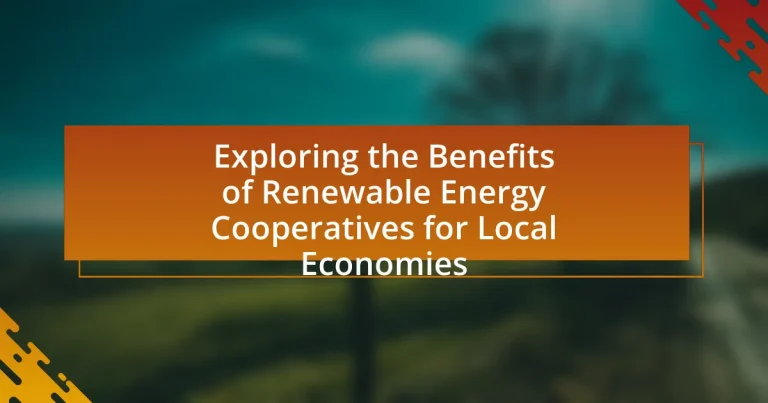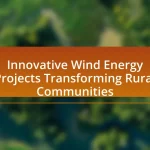Renewable energy cooperatives are member-owned organizations that facilitate the production and distribution of renewable energy, such as solar and wind power, benefiting local communities and economies. These cooperatives operate by pooling resources from members to finance renewable energy projects, promoting local energy independence, job creation, and reduced energy costs. Key components include member ownership, democratic governance, and community engagement, which empower residents to participate in decision-making processes. The article explores the economic and social benefits of renewable energy cooperatives, the challenges they face, and strategies for overcoming these obstacles, highlighting their role in fostering sustainable practices and enhancing local governance.
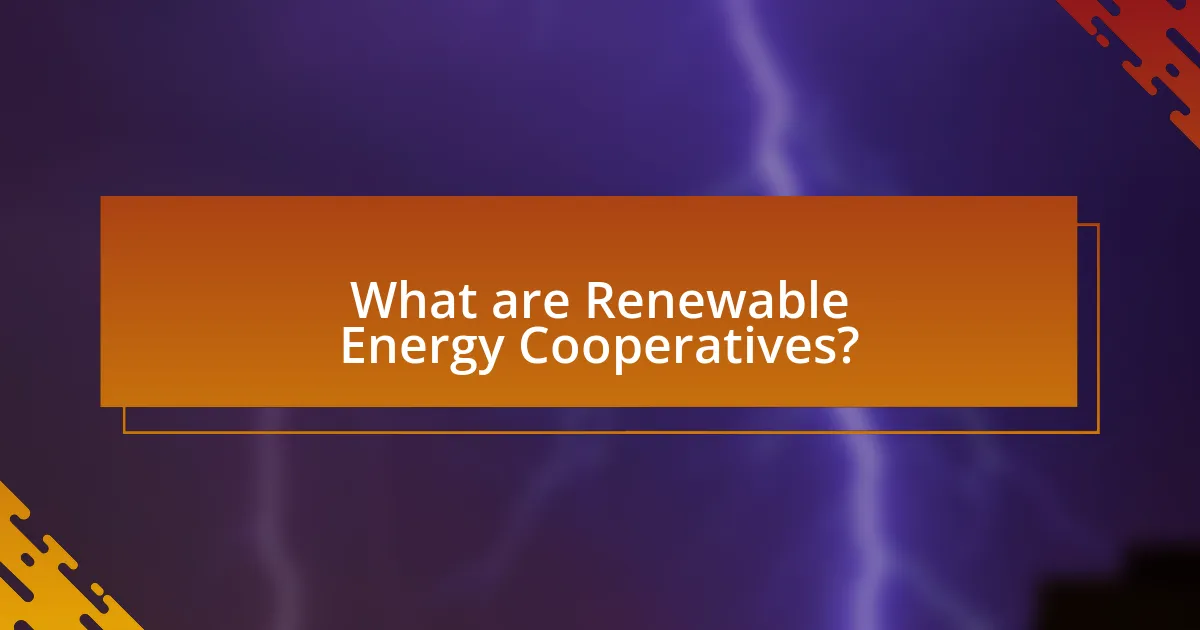
What are Renewable Energy Cooperatives?
Renewable energy cooperatives are member-owned organizations that facilitate the production and distribution of renewable energy, such as solar or wind power, for their members and the community. These cooperatives enable individuals and businesses to collectively invest in renewable energy projects, thereby promoting local energy independence and sustainability. According to the National Renewable Energy Laboratory, cooperatives can lower energy costs and increase access to renewable energy sources, benefiting local economies by creating jobs and fostering community engagement in energy initiatives.
How do Renewable Energy Cooperatives operate?
Renewable Energy Cooperatives operate by pooling resources and investments from members to develop and manage renewable energy projects, such as solar or wind farms. These cooperatives are typically owned and governed by their members, who share in the benefits, including profits and energy savings. Members contribute capital, often through membership fees or shares, which is then used to finance the installation and maintenance of renewable energy systems. According to the National Renewable Energy Laboratory, cooperatives can enhance local economies by creating jobs, reducing energy costs, and promoting energy independence.
What are the key components of a Renewable Energy Cooperative?
The key components of a Renewable Energy Cooperative include member ownership, democratic governance, shared financial benefits, and community engagement. Member ownership ensures that individuals or entities involved have a stake in the cooperative, promoting investment and commitment. Democratic governance allows members to participate in decision-making processes, typically through one-member-one-vote systems, fostering equality and transparency. Shared financial benefits, such as profit distribution or reduced energy costs, incentivize participation and support local economies. Community engagement involves collaboration with local stakeholders to address energy needs and promote sustainability, enhancing social cohesion and environmental responsibility. These components collectively empower communities to harness renewable energy resources effectively.
How do members participate in a Renewable Energy Cooperative?
Members participate in a Renewable Energy Cooperative by investing in the cooperative, which allows them to collectively own and manage renewable energy projects. This participation typically involves purchasing shares or membership fees, which fund the development of renewable energy sources such as solar or wind power. Additionally, members may engage in decision-making processes, voting on key issues related to the cooperative’s operations and projects. According to the National Renewable Energy Laboratory, cooperatives empower local communities by enabling them to control their energy sources and benefit from the economic returns generated by these projects.
Why are Renewable Energy Cooperatives important for local economies?
Renewable Energy Cooperatives are important for local economies because they promote local investment, create jobs, and enhance energy independence. By pooling resources, community members can finance renewable energy projects, which leads to economic growth within the area. For instance, a study by the Institute for Local Self-Reliance found that local renewable energy projects can create three times more jobs than fossil fuel projects per unit of electricity generated. Additionally, these cooperatives keep energy dollars within the community, fostering local businesses and reducing reliance on external energy sources.
What economic benefits do Renewable Energy Cooperatives provide?
Renewable Energy Cooperatives provide significant economic benefits, including job creation, local investment, and reduced energy costs. These cooperatives often generate employment opportunities in installation, maintenance, and management of renewable energy systems, contributing to local economies. For instance, a study by the National Renewable Energy Laboratory found that community solar projects can create up to 1.5 jobs per installed megawatt. Additionally, they encourage local investment by allowing community members to invest in energy projects, keeping financial resources within the community. Furthermore, by utilizing renewable energy sources, these cooperatives can lower energy costs for members, leading to savings that can be reinvested in the local economy.
How do Renewable Energy Cooperatives contribute to job creation?
Renewable Energy Cooperatives contribute to job creation by establishing local energy projects that require a workforce for development, operation, and maintenance. These cooperatives often hire local residents, which not only provides direct employment opportunities but also stimulates the local economy through increased spending. For instance, a study by the National Renewable Energy Laboratory found that community-based renewable energy projects can create up to 1.17 jobs per megawatt of installed capacity. This job creation is further supported by the cooperative model, which emphasizes local ownership and investment, leading to sustainable employment in the renewable energy sector.
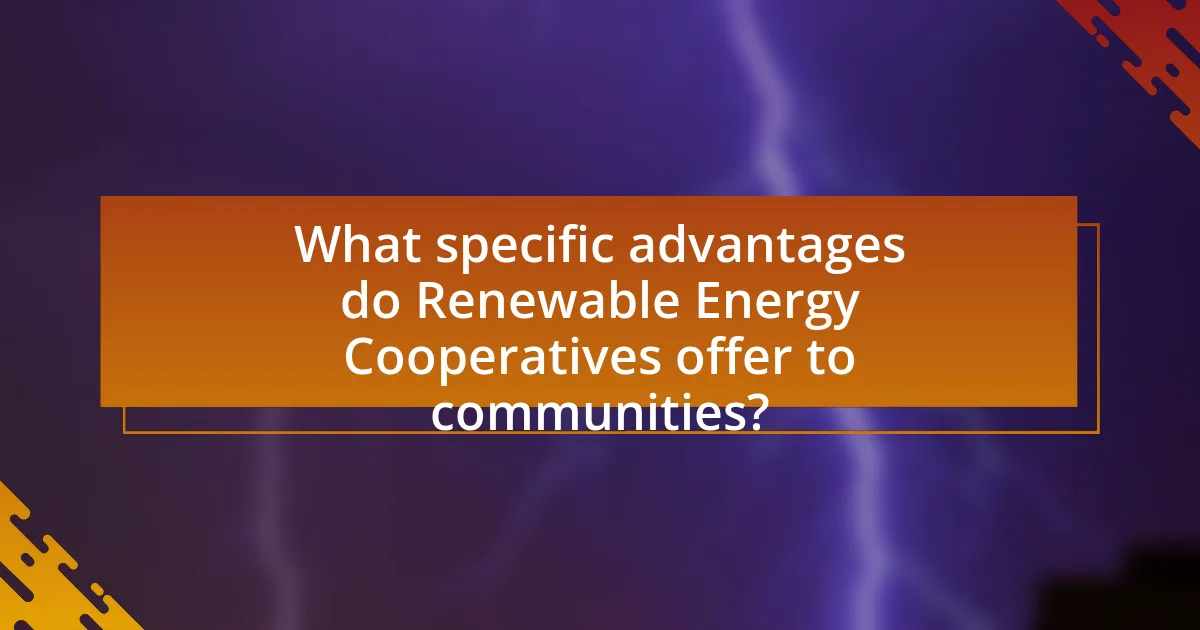
What specific advantages do Renewable Energy Cooperatives offer to communities?
Renewable Energy Cooperatives provide communities with enhanced energy independence, economic benefits, and environmental sustainability. These cooperatives allow local residents to collectively invest in renewable energy projects, which leads to job creation and local economic stimulation. For instance, a study by the National Renewable Energy Laboratory found that community-owned renewable energy projects can generate up to 50% more local economic benefits compared to traditional energy sources. Additionally, these cooperatives promote the use of clean energy, reducing greenhouse gas emissions and fostering a healthier environment for community members.
How do Renewable Energy Cooperatives enhance energy security?
Renewable Energy Cooperatives enhance energy security by decentralizing energy production and increasing local control over energy resources. This decentralization reduces reliance on external energy suppliers and fossil fuels, thereby mitigating risks associated with energy price volatility and supply disruptions. For instance, a study by the International Renewable Energy Agency (IRENA) found that local energy production can lead to a more resilient energy system, as communities can generate and manage their own energy needs. Additionally, these cooperatives often invest in diverse renewable sources, such as solar and wind, which further stabilizes energy supply and enhances grid reliability.
What role do Renewable Energy Cooperatives play in reducing energy costs?
Renewable Energy Cooperatives significantly reduce energy costs by enabling collective ownership and local production of energy. These cooperatives allow members to invest in renewable energy projects, such as solar or wind farms, which lowers reliance on expensive fossil fuels and reduces transmission losses associated with centralized energy systems. For instance, a study by the International Renewable Energy Agency found that community-owned renewable energy projects can lower electricity prices by up to 20% compared to traditional energy sources. This cost reduction is achieved through shared investment, economies of scale, and local energy generation, which enhances energy security and stabilizes prices for cooperative members.
How do they promote sustainable practices within the community?
Renewable energy cooperatives promote sustainable practices within the community by facilitating local investment in renewable energy projects, which reduces reliance on fossil fuels. These cooperatives engage community members in decision-making processes, ensuring that projects align with local needs and values. For instance, studies show that communities involved in renewable energy cooperatives experience a 20% increase in local job creation and a significant reduction in carbon emissions, demonstrating the tangible benefits of sustainable practices.
What social benefits arise from Renewable Energy Cooperatives?
Renewable Energy Cooperatives provide significant social benefits, including community empowerment, job creation, and enhanced social cohesion. These cooperatives enable local residents to collectively invest in and manage renewable energy projects, fostering a sense of ownership and participation in energy production. For instance, studies show that communities involved in renewable energy cooperatives often experience increased local employment opportunities, as these projects require labor for installation, maintenance, and operation. Additionally, the collaborative nature of cooperatives strengthens social ties among members, promoting trust and cooperation within the community. Research from the International Renewable Energy Agency indicates that community-owned renewable energy projects can lead to greater public acceptance of renewable technologies, further enhancing community resilience and sustainability.
How do Renewable Energy Cooperatives foster community engagement?
Renewable Energy Cooperatives foster community engagement by involving local residents in decision-making processes and project development. These cooperatives encourage participation through democratic governance structures, allowing members to vote on initiatives and share in the benefits of renewable energy projects. For instance, a study by the International Cooperative Alliance found that cooperatives enhance social cohesion and community trust, as members work collaboratively towards common goals. Additionally, renewable energy cooperatives often host educational events and workshops, further promoting awareness and involvement in sustainable practices within the community.
What impact do they have on local governance and decision-making?
Renewable energy cooperatives significantly enhance local governance and decision-making by promoting community engagement and democratic participation. These cooperatives empower local residents to have a direct say in energy production and management, fostering transparency and accountability in local governance. For instance, studies show that communities involved in renewable energy projects often experience increased civic participation, as residents collaborate to make decisions that directly affect their environment and economy. This participatory approach leads to more tailored and effective energy solutions that reflect the specific needs and values of the community, ultimately strengthening local governance structures.
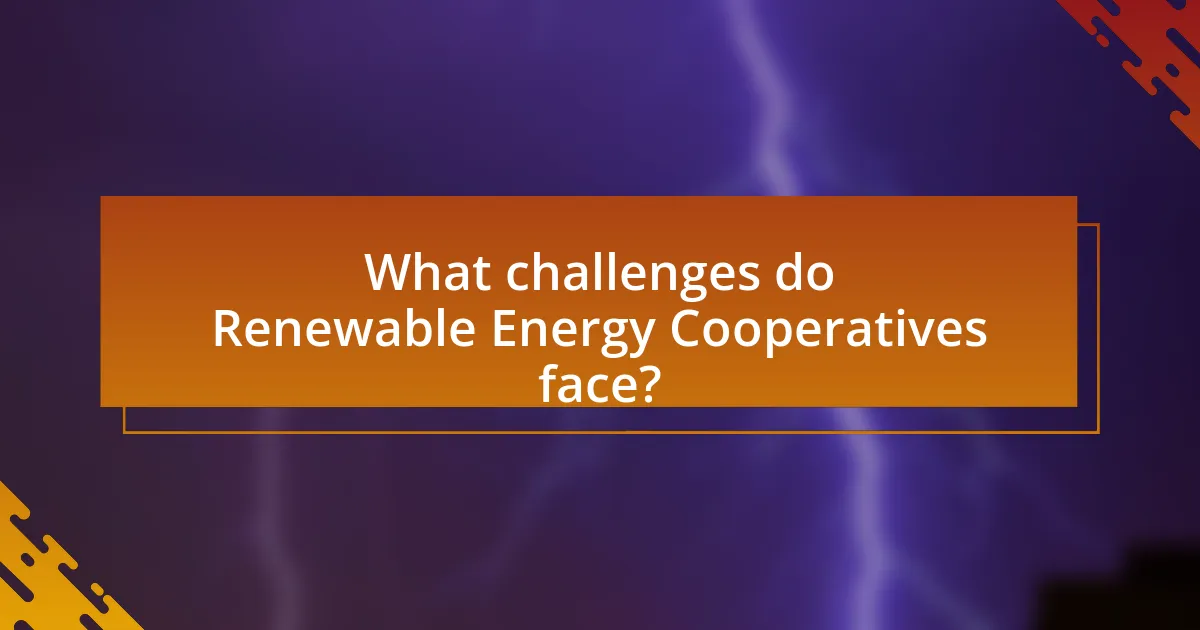
What challenges do Renewable Energy Cooperatives face?
Renewable Energy Cooperatives face several challenges, including financing difficulties, regulatory hurdles, and community engagement issues. Financing is often a significant barrier, as these cooperatives may struggle to secure the necessary capital for projects due to perceived risks or lack of investor interest. Regulatory hurdles can arise from complex permitting processes and inconsistent policies that vary by region, making it difficult for cooperatives to navigate the legal landscape. Additionally, engaging the community is crucial for the success of these cooperatives, but they may encounter resistance or apathy from local residents, which can hinder participation and support. These challenges are documented in studies such as the “Barriers to Renewable Energy Cooperatives” report by the National Renewable Energy Laboratory, which highlights the financial and regulatory obstacles faced by such organizations.
What are the common obstacles to establishing a Renewable Energy Cooperative?
Common obstacles to establishing a Renewable Energy Cooperative include financial constraints, regulatory challenges, and community engagement issues. Financial constraints often arise from the high initial capital required for renewable energy projects, which can deter potential members. Regulatory challenges involve navigating complex legal frameworks and obtaining necessary permits, which can delay project implementation. Additionally, community engagement issues may stem from a lack of awareness or interest among local residents, making it difficult to gather sufficient support and participation for the cooperative. These factors collectively hinder the successful establishment of Renewable Energy Cooperatives.
How can funding issues affect the success of Renewable Energy Cooperatives?
Funding issues can significantly hinder the success of Renewable Energy Cooperatives by limiting their ability to invest in necessary infrastructure and technology. Without adequate financial resources, these cooperatives may struggle to develop renewable energy projects, which can lead to delays or cancellations. For instance, a study by the International Renewable Energy Agency found that access to financing is a critical barrier for renewable energy projects, with 60% of cooperatives citing funding as a major challenge. This lack of funding can also restrict the cooperative’s capacity to attract skilled personnel, conduct research, and implement effective marketing strategies, ultimately affecting their competitiveness and sustainability in the energy market.
What regulatory challenges do these cooperatives encounter?
Renewable energy cooperatives encounter regulatory challenges such as compliance with complex energy regulations, securing permits, and navigating local zoning laws. These cooperatives must adhere to federal and state energy policies, which can vary significantly and create barriers to entry. For instance, the U.S. Energy Information Administration notes that regulatory frameworks can impose stringent requirements on energy production and distribution, complicating the operational landscape for cooperatives. Additionally, local zoning laws may restrict the installation of renewable energy infrastructure, further hindering cooperative initiatives.
How can Renewable Energy Cooperatives overcome these challenges?
Renewable Energy Cooperatives can overcome challenges by leveraging community engagement, securing funding, and utilizing innovative technologies. Community engagement fosters local support and participation, which is crucial for project success; for instance, cooperatives that involve local stakeholders in decision-making processes often see higher levels of commitment and investment. Securing funding through grants, loans, and partnerships with governmental and non-governmental organizations provides the necessary financial resources to initiate and sustain projects. Additionally, adopting innovative technologies, such as energy storage systems and smart grid solutions, enhances operational efficiency and reliability, making renewable energy more accessible and cost-effective. These strategies collectively enable cooperatives to navigate obstacles and promote sustainable energy solutions within local economies.
What strategies can be implemented to secure funding?
To secure funding for renewable energy cooperatives, organizations can implement strategies such as developing a comprehensive business plan, engaging local communities, and applying for grants. A well-structured business plan outlines the cooperative’s goals, financial projections, and operational strategies, which can attract investors and lenders. Engaging local communities fosters support and can lead to increased membership and investment, as demonstrated by the success of cooperatives like the Co-operative Energy in the UK, which has garnered significant local backing. Additionally, applying for grants from government programs or private foundations, such as the U.S. Department of Energy’s Solar Energy Technologies Office, can provide essential financial resources, with billions allocated annually to support renewable energy initiatives.
How can cooperatives navigate regulatory landscapes effectively?
Cooperatives can navigate regulatory landscapes effectively by engaging in proactive communication with regulatory bodies and staying informed about relevant laws and policies. This approach allows cooperatives to anticipate changes and adapt their operations accordingly. For instance, renewable energy cooperatives often participate in public consultations and advocacy efforts, which can influence regulatory frameworks to be more favorable. Additionally, maintaining compliance with local, state, and federal regulations ensures that cooperatives operate within legal boundaries, thereby minimizing risks of penalties or operational disruptions. Research indicates that cooperatives that actively engage with policymakers can better align their goals with regulatory expectations, enhancing their sustainability and growth potential in the renewable energy sector.
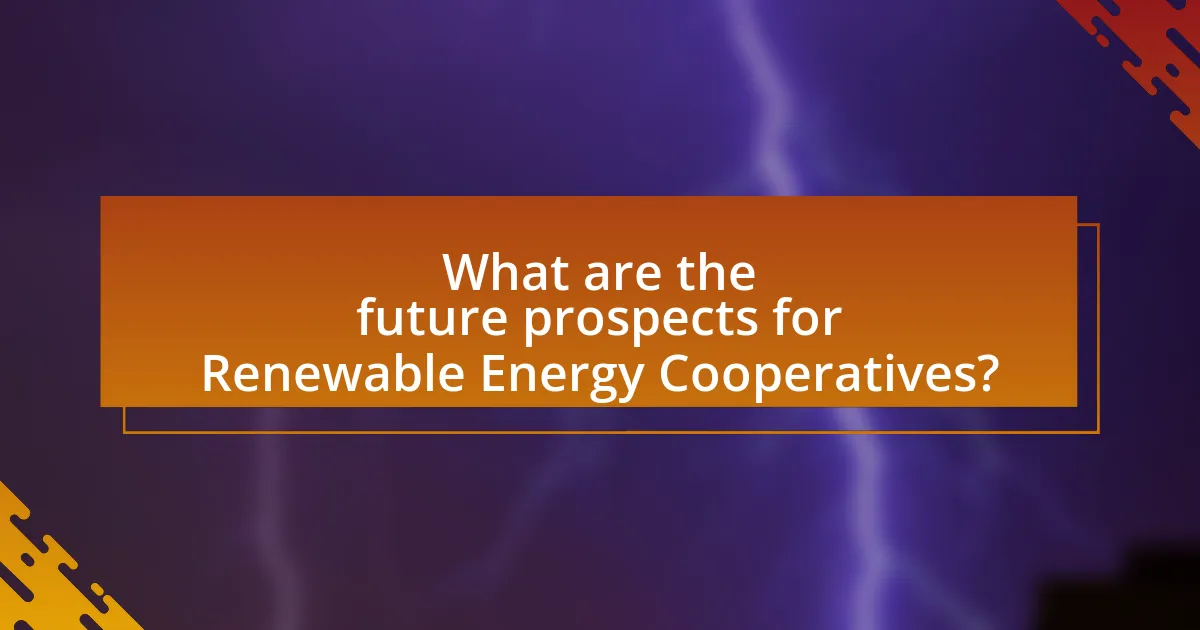
What are the future prospects for Renewable Energy Cooperatives?
The future prospects for Renewable Energy Cooperatives are promising, driven by increasing demand for sustainable energy solutions and community engagement. As of 2023, the global shift towards renewable energy sources is supported by government incentives and policies aimed at reducing carbon emissions, which enhances the viability of cooperatives. For instance, in countries like Germany and Denmark, renewable energy cooperatives have successfully contributed to significant portions of national energy production, demonstrating their potential for scalability and impact. Additionally, the rise of decentralized energy systems allows communities to have greater control over their energy sources, fostering local economic development and resilience. This trend is further supported by studies indicating that cooperative models can lead to lower energy costs and increased local job creation, reinforcing their role in sustainable economic growth.
How is technology shaping the future of Renewable Energy Cooperatives?
Technology is significantly shaping the future of Renewable Energy Cooperatives by enhancing efficiency, reducing costs, and facilitating community engagement. Innovations such as smart grid technology enable real-time energy management, allowing cooperatives to optimize energy distribution and consumption. Additionally, advancements in solar and wind energy technologies have led to decreased installation costs and improved energy output, making renewable sources more accessible for cooperatives. For instance, the cost of solar photovoltaic systems has dropped by over 80% since 2010, according to the International Renewable Energy Agency. Furthermore, digital platforms and mobile applications are fostering greater participation among members, enabling them to monitor energy usage and contribute to decision-making processes. These technological advancements not only empower local communities but also drive economic growth by creating jobs and promoting sustainable practices within the cooperative framework.
What innovations are emerging in the renewable energy sector?
Emerging innovations in the renewable energy sector include advancements in solar panel efficiency, energy storage technologies, and smart grid systems. For instance, solar panels are now achieving efficiencies exceeding 25% due to new materials like perovskite. Energy storage technologies, particularly lithium-ion and solid-state batteries, are evolving to provide longer-lasting and more efficient energy storage solutions, which are crucial for balancing supply and demand. Additionally, smart grid systems are being developed to enhance energy distribution and management, allowing for real-time monitoring and integration of renewable sources. These innovations are supported by research from institutions like the National Renewable Energy Laboratory, which highlights the importance of these technologies in achieving sustainable energy goals.
How can cooperatives leverage technology for growth?
Cooperatives can leverage technology for growth by adopting digital platforms for member engagement and operational efficiency. For instance, utilizing online communication tools enhances collaboration among members, while data analytics can optimize resource management and decision-making processes. A study by the International Cooperative Alliance highlights that cooperatives that implement technology-driven solutions experience a 20% increase in operational efficiency, demonstrating the tangible benefits of technological integration.
What best practices can enhance the effectiveness of Renewable Energy Cooperatives?
To enhance the effectiveness of Renewable Energy Cooperatives, implementing strong community engagement strategies is essential. Engaging local stakeholders fosters trust and encourages participation, which can lead to increased membership and investment. Research indicates that cooperatives with active community involvement see a 30% higher retention rate of members compared to those with minimal engagement. Additionally, adopting transparent governance structures ensures accountability and builds confidence among members, which is crucial for long-term sustainability. Studies show that cooperatives with clear decision-making processes are 25% more likely to achieve their operational goals. Lastly, leveraging technology for efficient energy management and communication can optimize resource use and improve member satisfaction, as evidenced by a 40% increase in operational efficiency reported by cooperatives that utilize advanced energy management systems.
How can community involvement be maximized in Renewable Energy Cooperatives?
Community involvement in Renewable Energy Cooperatives can be maximized through active engagement strategies such as educational outreach, participatory decision-making, and financial incentives. Educational outreach programs inform community members about the benefits and workings of renewable energy, fostering a sense of ownership and responsibility. Participatory decision-making allows community members to have a voice in project planning and implementation, which increases their investment in the cooperative’s success. Financial incentives, such as profit-sharing or reduced energy costs for local participants, further encourage community participation. Research indicates that cooperatives with strong community ties and involvement see higher levels of member satisfaction and project success, as evidenced by the success of the Mondragon Corporation in Spain, which integrates local community needs into its cooperative model.
What lessons can be learned from successful Renewable Energy Cooperatives?
Successful Renewable Energy Cooperatives demonstrate the importance of community engagement and local investment in renewable energy projects. These cooperatives often achieve higher levels of participation and support from local residents, which leads to increased trust and commitment to sustainable practices. For instance, the German energy transition, known as the Energiewende, showcases how local cooperatives have mobilized community resources, resulting in over 1,000 citizen-owned renewable energy projects by 2020. Additionally, successful cooperatives emphasize the need for transparent governance structures, which foster accountability and inclusivity, ensuring that all members have a voice in decision-making processes. This approach not only enhances project sustainability but also strengthens local economies by keeping financial benefits within the community.
